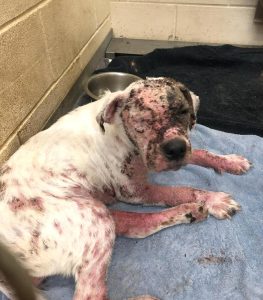Module 3: Healthcare practices for common medical conditions in shelters
Later That Day….

Later that same Monday, an ACO brought in a stray adult male dog from the field. The kennel staff performing the intake procedures according to the Gatorland Animal Services SOPs reported to Dr. Wright that the dog had severe skin disease and he did not know whether to give vaccines and parasite treatments.
Dr. Wright determined the dog did not have a fever and authorized vaccinations and parasite treatments with pyrantel pamoate, Heartgard Plus, and Frontline Plus according to protocol. A small blood sample was collected for heartworm testing – the canine heartworm antigen and microfilaria tests were negative.
On physical exam, she noted that the dog was squinting both eyes and had purulent ocular discharge; had inflamed swollen ear canals; severe generalized and patchy alopecia of the head, trunk, and legs; erythematous and thickened skin with adherent yellow plaques in the alopecic areas; crusts with hemorrhage on the face and head; severe pruritis; and a strong seborrhea odor.
Dr. Wright asked the vet tech to perform a superficial and a deep skin scrape to look for Sarcoptes and Demodex mites. Dr. Wright performed fluorescein staining of both corneas but there were no ulcers.
No Sarcoptes mites were found on the superficial scrape, but numerous Demodex adults and larvae were seen on the deep scrape.
Dr. Wright asked the vet tech about the shelter policy for treating dogs with generalized demodectic mange. The tech replied that the shelter did not treat these dogs because they didn’t have a staff veterinarian before. The normal policy is to send a plea out to rescue groups to take the dog for treatment, but if no one takes the dog after 7 days, it is euthanized. The tech also said that the shelter admits many mange dogs each year and many of them are eventually euthanized.
Dr. Wright realized that she not only needed to write an emergency plan SOP, but also SOPs for diagnosis and treatment of common diseases and illnesses in shelters.
ASV Guidelines Statements on Protocols for Common Illnesses
- Protocols for documenting and reporting health concerns are essential and the shelter veterinarian should be consulted on all policies and protocols related to the maintenance of medical and behavioral animal health.
- Protocols to define and manage common illnesses based on clinical signs should be developed and used in consultation with a veterinarian.
- Protocols should detail the expected course of disease and response to treatment. Veterinary input should be sought when disease or response to treatment does not follow expected course.
- Protocols may include ‘standing medical orders’ which are written documents that describe the actions staff should take when they encounter a special clinical situation. These orders typically include a list of the clinical signs associated with a particular medical condition and instructions on how to provide care.
- Medications and treatments are only administered with the advice of a veterinarian or in accordance with written protocols provided by a veterinarian.
Dr. Wright created a list of common infectious diseases in shelters to write SOPs for. Here is her list to start. (Contagious diseases such as respiratory infections, parvovirus and panleukopenia, and ringworm will be covered in Module 4)
- Demodex mange in dogs and cats
- Sarcoptes mange in dogs
- Notoedres mange in cats
- Otodectes ear mites in dogs and cats
- Bacterial infections (skin, wounds, abscesses)
- Canine heartworm infection
- FeLV or FIV infection

